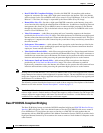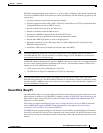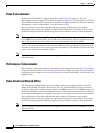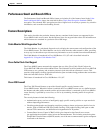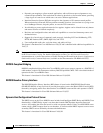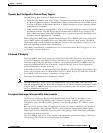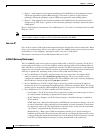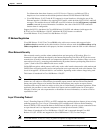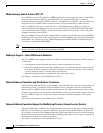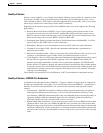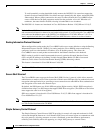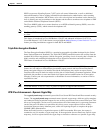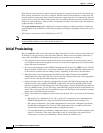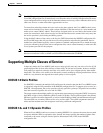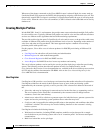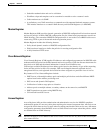
1-10
Cisco uBR924 Software Configuration Guide
OL-0337-05 (8/2002)
Chapter 1 Overview
Cisco IOS Software Release Feature Sets
Media Gateway Control Protocol V12.1.3T
Cisco IOS Release 12.1(3)T for the Cisco uBR924 cable access router supports version 0.1 of the Media
Gateway Control Protocol (MGCP), a proposed IETF voice control protocol that is intended to
eventually supersede the existing SCGP 1.1 protocol. The MGCP 0.1 and SGCP 1.1 protocols have been
merged on the Cisco uBR924 router so that the router can respond efficiently to either protocol.
The Cisco uBR924 cable access router functions as a Residential Gateway (RGW), providing an
interface between analog FXS phone or fax systems and the Voice over IP (VoIP) network. The RGW
uses a Trunking Gateway (TGW) to contact the call agent, which in turn provides access to the public
telephone switched network (PTSN).
The Cisco uBR924 cable access router supports both call waiting and caller ID when using either MGCP
or SGCP for call control. Each of the two voice ports on the Cisco uBR924 router can be configured with
the IP address for a default call agent. SNMP management of both the MGCP and SNMP protocols is
provided by a single MIB (XGCP-MIB).
Note This feature is described in detail in the Media Gateway Control Protocol Version 12.1.3T feature
module, available on CCO and the Documentation CD-ROM.
NetRanger Support—Cisco IOS Intrusion Detection
The Cisco uBR924 router supports NetRanger, which is an Intrusion Detection System (IDS) composed
of three parts:
• A management console (director) that displays alarms and manages the sensors.
• One or more sensors that monitor traffic, comparing it to a list of known signatures to detect misuse
of the network. When a signature is matched, the sensor can take certain actions, such as resetting
a session, dropping traffic, or sending alarms to the director.
• Automated report generation of standardized and customizable reports.
This feature is introduced in Cisco IOS Release 12.0(7)T.
Network Address Translation and Port Address Translation
Network address translation (NAT) and port address translation (PAT) frees a private network from the
requirement of having a worldwide unique IP address for every computer connected to the Internet.
Instead, the Cisco uBR924 router translates the IP addresses used on the private network into a global
IP address that can be used on the Internet. One IP address can be used for multiple computers because
the Cisco uBR924 router uses a unique port address to identify individual computers on the private
network.
This feature is introduced in Cisco IOS Release 12.0(4)XI1.
Network Address Translation Support for NetMeeting Directory (Internet Locator Service)
Microsoft NetMeeting is a Windows-based application that allows users to interact and collaborate using
their PCs over the Internet or an intranet. Previously, users had to know the IP addresses of other users’
PCs to make a connection. The NetMeeting Directory (ILS) feature enables the users to connect by using
the names that are in the directory built into the NetMeeting application. Users no longer need to know
the destination IP addresses to make a connection.
This feature is introduced in Cisco IOS Release 12.1(5)T.



